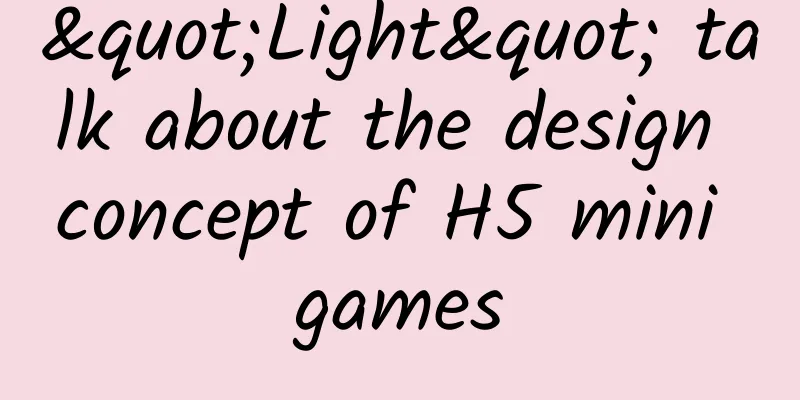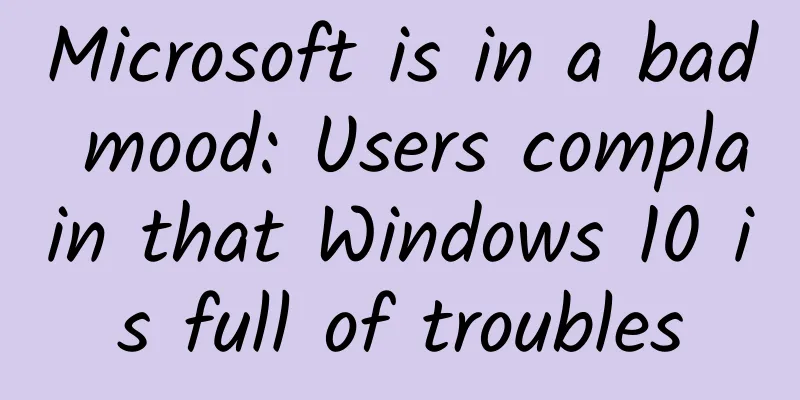"Light" talk about the design concept of H5 mini games

|
I. Introduction Since my main job recently is to write plans for H5 mini-games, my understanding of this aspect has become increasingly profound, so I would like to share it with you. The development of small games based on H5 is the company's strategy, so I will not elaborate on the advantages and disadvantages of H5 technology here. I will just share some design experience and methods of small games. 2. Features of H5 Mini Games Since we are going to develop a small game based on H5, we should understand its characteristics and advantages. In the past development process, we learned that the development cycle of H5 games is short, the diffusion is strong, and the content is mainly presented through the browser. This means that it has the characteristics of fast dissemination, poor retention compared to terminal mobile games, and is more dependent on the network and relatively fast experience. These characteristics all point to a game design with a lightweight design that can be quickly experienced and spread. For example, "Nervous Cat" and "Searching for the Right Place" are easy-to-use and highly diffusible products. Knowing these characteristics, we can try to summarize the design concepts that our small games developed based on H5 should have. 3. Design concept for H5 mini games 1. We are light, so we are fast The transmission speed of 2G and 3G and the low WiFi coverage force us to make the H5 mini-game smaller and lighter. This can be an advantage. Light means fast, and the information age requires speed. Fast transmission can make mini-games a carrier of information and a tool for attracting traffic. The current trend of mobile games is more serious. Lightweight games and disposable design concepts may become the needs of players in the next stage. Therefore, the smaller the size of H5 games, the better, and the simpler the rules, the better. Simplicity does not mean giving up playability. Simplicity is a design concept, which in return is ease of use and small size. For example, the earlier "Penguin Fight" was small in size, spread quickly, and was easy to use. 2. This is an era where appearance matters Light means that you need to use fewer art resources. If a game lacks gorgeous special effects and exquisite original paintings, how can it cater to this era of appearance? The answer I can give at present is simple and bright. Just like you don’t have delicate facial features and a perfect figure, but at least you should be clean and hold your head high. What we want is temperament. For example, "CannonHero" and "Halos" have simple backgrounds and elements, bright characters and scenes. The effect created by this art style is more in line with the concept of "lightness". Simple art corresponds to simple gameplay, and bright colors correspond to easy-to-use and relaxing experience. PS: At this stage, pixels are the most powerful weapon. 3. Hidden level design The level design of traditional games mainly provides players with purpose and stickiness. However, mini-games are less dependent on these two. Strong level concept design will destroy the design concept of "lightness" for mini-games, making players of mini-games that are mainly based on relaxation feel psychologically burdened. However, if a game does not have a sense of hierarchy, it will also be a very bad experience, just like playing a game of "flappybird" without scoring. Therefore, the design of scoring can enhance the player's sense of superiority and a little stickiness, and it is also the basis for judging other system designs, such as increasing the difficulty of the game. The hidden levels mainly highlight the sense of hierarchy. Many mini-games will automatically change the color of the background image for you when your score reaches a certain stage. Such simple design and art resources will not increase the size of the game too much, and at the same time make your experience have a sense of hierarchy. You will clearly know that you have entered the "next stage" instead of running foolishly on a road with no end. Such a simple design will highlight the design sense of the game and improve the experience. "Mini-game" does not mean it is "stupid simple". 4. Micro-growth The carrier of mini-games is not only browsers, but also platforms, which slightly improves the common problem of poor retention of mini-games. Imagine if you click on a mini-game from Moments and upgrade it to level ten. When you get tired of playing and close the browser, your data disappears with it, which is an experience that will frustrate players. If I need to save this mini-game, in addition to Moments providing me with a download entrance, I can only collect web pages through the browser's collection function. This makes the originally quick design stupid and dumb. At this stage, many platforms have opened up the management of mini-games. You can manage the mini-games you have played on the platform, which allows mini-games to do some growth design to increase user stickiness and retention. For example, "Foolish Old Man Moves Mountains" in QQ Space. Why micro-growth? Again, what we want is "lightness". Heavy growth systems will not increase retention. Users choose mini-games for the purpose of stress relief with a light experience. If they pursue a complete growth system, users will choose mobile games or even PC games. Micro-growth can be a placement-type design, or simply accumulating game coins to purchase other images of the character. It is always better to have a goal than to have no goal at all. 5. Operational inertia The "lightness" of mini-games makes the gameplay design tend to be a design with only failures instead of successes. For example, "flappy bird" and "surround the crazy cat", etc., players want to show off their score output. This makes mini-games usually take the route of puzzle or agility. The inertia of mini-games with this kind of gameplay is particularly important. The simple way is to put a big restart button on the end interface to attract players to repeat the challenge. The most important thing is that the gameplay of the game must be challenging and playable. For example, "Crazy Labs". Don't make obvious landmark nodes when the game fails, which will weaken the inertia. The specific experience is that this interface gives players the feeling that the game has failed rather than the game is over. 4. This is a trend I have been talking for so long and I don’t have too much nonsense. The trend is the trend. Tencent’s Play, 360’s H5 mini-game special, MoLin, Egret and so on, I don’t know if this is the next era, but it must be a new way of playing. |
<<: APIStore——Technology innovation thinking from Baidu
>>: Animation Interaction Learning Guide Inspired by Google Motion Design
Recommend
The hidden worries behind Netflix's stock price frenzy
Today, Netflix, the American video streaming comp...
Do plants have vision? The challenges and controversies of interpreting plant perception
Do plants have vision? Written by | Xiaoye In the...
A Scientific Genius Dancing in the Wind: Commemorating the 60th Anniversary of von Karman's Death
Theodore von Karman is a representative figure in...
Why does sending voice messages on WeChat indicate low emotional intelligence and impoliteness?
Many people may have had this experience: when yo...
Three subtle details of Swift extensions
Whenever I first look at a document, I skim throu...
37 public account editing skills that new media people must know!
When creating content for a public account, there...
France closes all schools! How long will it be closed? Will transportation be open?
At 8 p.m. on March 12, French President Macron de...
Paying someone to rate your looks? Don't take it too seriously
Recently, "rating appearance" has becom...
51CTO Academy and Xingyu Spacetime have reached a strategic cooperation in VR online education - VR training courses will be launched
Pictured from left to right: Chen Bo, Vice Presid...
From the "reputation-building missile" to Huawei's "reputation-building aircraft", what other "technological breakthroughs" are there on the road to becoming a strong country that you don't know about?
Planning: Little Dandelion, 91 Copywriter: Xiaoxi...
Private domain marketing plan for the medical beauty industry!
In this age where looks matter, appearance anxiet...
The "king of new materials" mentioned in "Dream Pool Essays"! What exactly is graphene?
If you ask what new material is the hottest nowad...
Will eating persimmons on an empty stomach cause kidney stones? Will eating persimmons make anemia patients' condition worse? Pay attention to these 3 points and eat persimmons without worry →
gossip Autumn is a time for abundant harvests. Th...
As semiconductor giants compete in autonomous driving, how much chance does Intel, which acquired Mobileye, have?
Intel, which stuck to the X86 chip architecture, ...
Case Study: 12 Gamification Strategies for User Growth
This article uses a case study to introduce how t...









